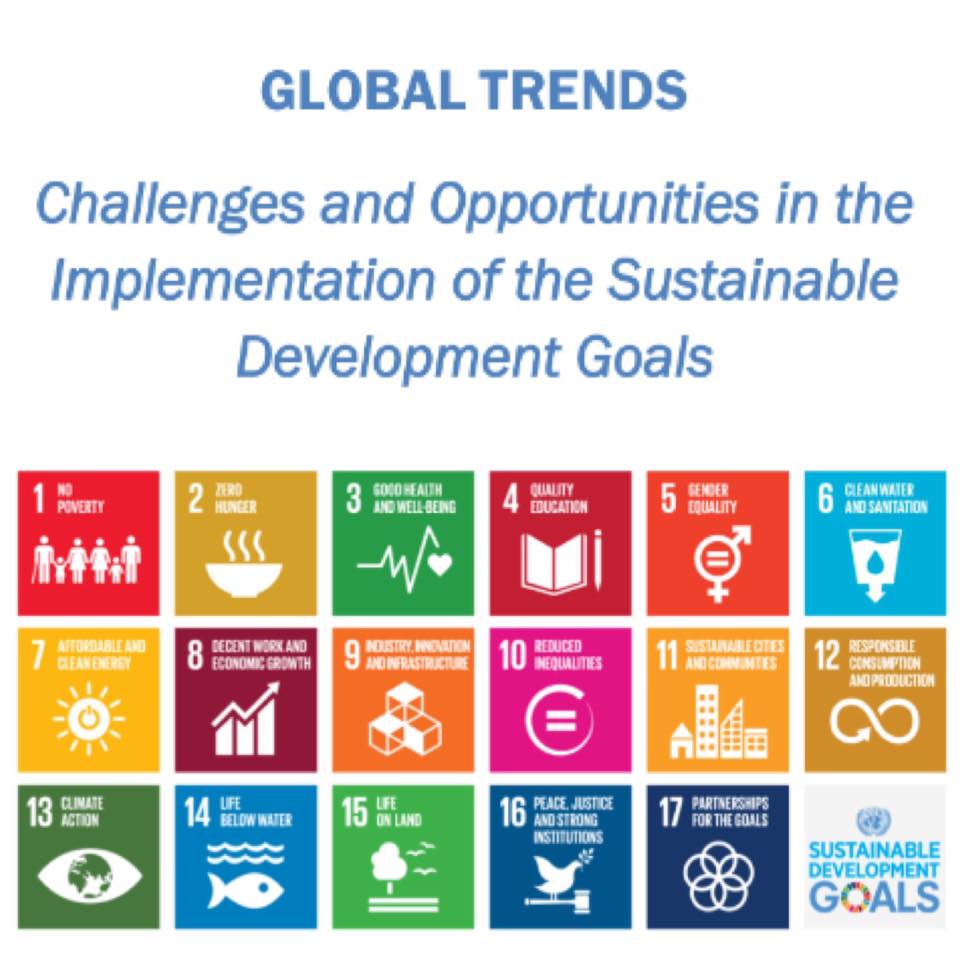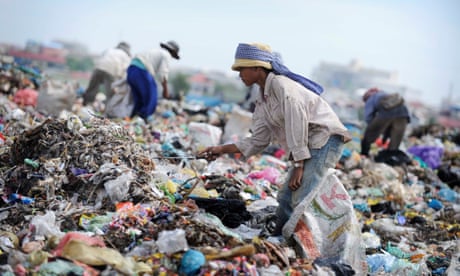Man-made
environmental degradation is one of the challenging megatrends that
humanity faces today.
Photograph: Blickwinkel/Alamy Stock Photo
New report on Global Trends: Challenges and Opportunities in implementation of #SDGs" is now out http://goo.gl/BVXKx7 #globalgoals @UNDP
 Global development professionals network
Global development professionals network Development 2030
Six mega trends that could alter the course of sustainable development
As the world works to achieve the sustainable development goals, a recent UN report identifies six issues that challenge ambitious targets
Esuna Dugarova and Nergis Gülasan
Policy specialists in the strategic policy unit at the UN Development Programme
Friday 14 April 2017
We are approaching two years into implementing the ambitious 2030 Agenda
a historic agreement to:
- end poverty,
- combat inequalities,
- promote peaceful and inclusive societies, and
- protect the environment.
The new global framework, with 17 sustainable development goals (SDGs) at its core, commits to promoting development in an integrated way – economically, socially and environmentally – in all countries, ensuring that no one is left behind.
Our recently published report identifies six megatrends that will shape the trajectories of – and could potentially undermine – progress on the SDGs.
In the current context of a looming retreat from multilateralism, the choices governments and societies make to manage these long-term trends will be fundamental to whether the world can get onto a pathway of sustainable development.
1 | Poverty and inequalities
Substantial progress has been achieved in multiple dimensions of poverty in the past decades, including the reduction of absolute poverty, decline in child and maternal mortality rates, and improved access to clean water and sanitation facilities. Income inequality between countries has also been falling, mainly due to the rapid growth in large developing countries.

How can we reach an SDG target when we're moving in the wrong direction?
Despite these gains, the progress has been uneven and considerable challenges remain. These include rising income disparities within countries, persistent gender inequality and the recent resurgence of poverty across regions due to economic shocks and escalating conflicts.
The Multidimensional Poverty Index, which measures deprivation in health, education and living standards, counted 1.6 billion people living in multidimensional poverty in 2016 – nearly twice the number of people living in extreme poverty measured by income alone.
Progress towards eliminating poverty is more difficult during times of uncertain economic prospects, the report suggests. This is further complicated by weak labour market conditions, demographic changes, and conflicts and insecurity.
Evidence shows that while economic growth is essential for reducing poverty, a critical link between growth and the reduction of poverty and inequalities is related to the nature and quality of growth, and a balanced distribution of gains across all segments of society.
2 | Demography
The implementation of the 2030 Agenda will be affected by demographic dynamics, including population growth, ageing, migration and urbanisation. In 2015, 12.3% of the global population reached the age of 60 or over (pdf), with rapid ageing expected to occur in Europe, North America, Asia and Latin America.
In Africa, by contrast, populations are young, which provides an opportunity for a demographic dividend.
It has become easier for people to move, and factors such as poverty, unemployment, conflicts and natural hazards compel people to leave their homes in search of better lives. International migration has reached record levels (pdf), accounting for 244 million migrants worldwide in 2015. If managed well, migration will continue to bring profound benefits to sending countries through remittances, knowledge and networks, and to receiving countries by filling acute labour shortages and contributions in terms of taxes and care services.
Internal migration is also growing, driving fast increases in urbanisation. On one hand, urbanisation fosters growth and provides a higher quality of life, with cities accounting for more than 80% of global GDP (pdf).
On the other, it raises concerns about urban poverty, social tensions and disparities, changes in family patterns, and environmental risks.
3 | Environmental degradation and climate change
Major environmental challenges identified by the report include degradation of air and land, water scarcity, deforestation, marine pollution and a decline in biodiversity. Some of the underlying factors behind environmental degradation include population growth, polluting technologies, and overexploitation of ecosystems driven by unsustainable consumption and production patterns.
The first year of SDG implementation was marked by the slowest rate of economic growth since 2008 The world is already witnessing the impact of climate change on natural systems.
This is translated into the increasing frequency and severity of natural hazards (pdf), which lead to more disasters due to population growth (pdf) and patterns of economic development.
Climate change is also projected to undermine food security, exacerbate existing health threats, adversely affect water availability and lead to increased displacement.
In the coming decades, it is likely that this trend will continue, with more losses expected in livelihoods and assets. This underlines the link between poverty and vulnerability to natural hazards.
It also exposes inequity, as countries and populations likely to be most harmed by climate change impacts are often the least responsible for causing them, and have limited capacity and resources to cope with the consequences.
4 | Shocks and crises
The report discusses various shocks and crises including economic and financial shocks, disasters, conflicts and disease outbreaks that have undermined the precarious livelihoods of millions of people and can affect progress towards sustainable development.
Over the past decades, global forced displacement, for example, increased by 75% due to conflicts, violence and human rights violations.
Despite many obstacles, the world is getting better
Johan Norberg
The first year of SDG implementation was marked by the slowest rate of economic growth since the 2008 global financial crisis (pdf), weak investment growth and stagnant global trade. While progress has been made in reducing the global unemployment rate, nearly 201 million people worldwide (pdf) were estimated to be unemployed in 2016, including 71 million young people.
Global economic prospects remain subject to various risks, including increasing policy uncertainty in major advanced and emerging economies, financial market disruptions and heightened geopolitical tensions.
At the same time, remarkable achievements have been made in combating major infectious diseases and reducing hunger over the past decades, which can be attributed to political commitment, strong global partnerships and sound social protection policies.
Despite this, the world continues to face significant challenges in addressing health issues and under-nutrition, with nearly 800 million people suffering from hunger worldwide, and high risks of famine.
5 | Financing for development
To achieve the SDGs, development finance strategies need to go beyond filling financing gaps. While official development assistance will remain a vital source of external public finance for the poorest and most vulnerable countries, it will not be sufficient.
All sources of finance – public and private, domestic and international – need to be mobilised. In particular, effective domestic resource mobilisation will be at the core (pdf) of financing sustainable development.
There is no shortage of capital in the global economy While resources allocated for development objectives are not adequate, there is no shortage of capital in the global economy. The challenge is to enhance the impact of available resources, while catalysing additional sources of finance into investments in long-term sustainable development.
It is critical to better align private sector incentives with sustainable development objectives through strengthened policies and sound institutional, legal and regulatory frameworks. As a positive trend, the private sector’s involvement in philanthropic giving, corporate social responsibility initiatives, impact investing, and inclusive business approaches has been expanding.
A number of innovative multi-stakeholder partnerships such as the Global Fund and new financing mechanisms for development including green bonds have emerged since 2000. It will be essential to scale up the proven mechanisms in size, scope and geographical reach.
6 | Technological innovations
Technology is an important means for implementing the SDGs. The biggest technological advancements over the past decades have occurred in health, education and the environment. For example, the development of new vaccines against infectious diseases is estimated to save nearly 3 million lives every year.
Online courses and interactive applications expand access to education around the globe, providing new ways of learning, teaching and collaborative work. Renewable energy technologies are critical in addressing climate change and its negative impacts.
While technologies have provided innovative solutions to many development problems, they have also added new challenges and risks, including security and privacy concerns, polarising opportunities and job replacement.
Forecasts suggest that computers could do the work of 140 million knowledge workers by 2025, while 30% of middle-income jobs could be eliminated (pdf) due to innovation in artificial intelligence.
How to move forward?
The multiple crises and disasters in recent decades have highlighted unpredictability and volatility in the global economy, continued uncertainties and disruptions in people’s lives, and the vulnerability of development progress to external shocks.
Against this backdrop, there is a challenge – and an opportunity – for a sophisticated policy response of preparedness, investment and cooperation.
Old economics is based on false ‘laws of physics’ – new economics can save us
Kate Raworth
The report points to four main factors that are crucial in addressing these trends: the importance of evidence in decision-making; policy coherence across the global goals and at different levels of policymaking and implementation; collective action to maximise the positive dynamics in these areas and minimise risk; and broad-based inclusive participation.
Esuna Dugarova and Nergis Gülasan are policy specialists in the strategic policy unit at the UN Development Programme. Follow @Esuna_Dugarova on Twitter.
Esuna Dugarova @Esuna_Dugarova
Summary of our report on global trends: http://goo.gl/atzhjz Thank you @PJLaddUN @UNRISD & Pedro Conceição @UNDP for comments! #SDGs
Join our community of development professionals and humanitarians.
Follow @GuardianGDP on Twitter. Join the conversation with the hashtag #Dev2030.
Topics
Global development professionals network
Development 2030
Inequality and development
Maternal health
Access to water
Sanitation
Conflict and development
Source: https://www.theguardian.com/global-development-professionals-network/2017/apr/14/six-megatrendsthat-could-alter-the-course-of-sustainable-development

No comments:
Post a Comment